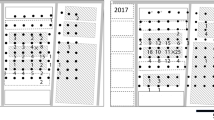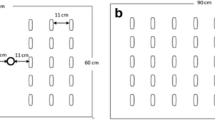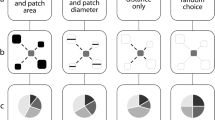Abstract
Laboratory populations of the sweet potato whitefly, Bemisia tabaci, have been shown to consist of both migratory and trivial flying morphs. The behavior of these forms as part of the process of short-range migration was examined under field conditions. Insects were marked in a field of melons using fluorescent dust during two consecutive growing seasons. During the first growing season, passive traps used to collect living whiteflies, were placed along 16 equally spaced transects radiating from the field to a distance of up to 1.0 km. Wind out of the north-east consistently carried migrating whiteflies to traps placed along transects in the south-western quadrant because cold air drainages dictate wind direction during early morning hours in the desert South-west. For this reason, during the second season traps were laid out over fallow ground in a rectangular grid extending 2.7 km to the south-west of the marked field. If dispersal was entirely passive, patterns could be described using a diffusion model. Statistical examination of the data, howèver, demonstrated that the distribution on all days was patchy. Geostatistical techniques were used to describe the observed patchiness. Traps in the immediate vicinity of the marked field caught more whiteflies than the daily median. Large numbers were also collected from near the periphery of the grid. White-flies were far less prevalent in the grid's center. As a result, the distribution of captured whiteflies can be described as bimodal. These patterns confirm behavior observed in the laboratory, i.e., a portion of the population are trivial fliers that do not engage in migration and are consequently captured in traps near the field, and a portion initially respond to cues associated with skylight, ignoring cues provided by the ground, and fly for a period of time before landing in distant traps. During both years movement out of the field had an exaggerated directional component on 13 of 14 days.
Similar content being viewed by others
References
Bellows TS Jr, Perring TM, Gill RJ, Headrick DH (1994) Description of a species of Bemisia (Homoptera: Aleyrodidae). Ann Entomol Soc Am 87:195–206
Blackmer JL, Byrne DN (1993a) Flight behaviour of Bemisia tabaci in a vertical flight chamber: effect of time of day, sex, age and host quality. Physiol Entomol 18:223–232
Blackmer JL, Byrne DN (1993b) Environmental and physiological factors influencing phototactic flight of Bemisia tabaci. Physiol Entomol 18:336–342
Borth PW, Huber RT (1987) Modeling bollworm establishment and dispersion in cotton with the kriging technique. In: 1987 Proceedings, Beltwide Cotton Production Conference, January 4–8, 1987 National Cotton Council of America, Memphis, pp 267–274
Brown PW, Machibya T, Russell B (1995) Wind flow patterns at the University of Arizona agricultural centers (Experimental Station Technical Bulletin 268). University of Arizona, Tucson, pp 1–215
Buntin GD, Gilbertz DA, Oetting RD (1993) Chlorophyll loss and gas exchange in tomato leaves after feeding injury by Bemisia tabaci. (Homoptera: Aleyrodidae). J Econ Entomol 86:517–522
Byrne DN, Bretzel PK von (1987) Similarity in flight activity rhythms in coexisting species of Aleyrodidae, Bemisia tabaci (Gennadius) and Trialeurodes abutilonea (Haldeman). Entomol Exp Appl 43:215–219
Byrne DN, Houck MA (1990) Morphometric identification of wing polymorphism in Bemisia tabaci (Homoptera: Aleyrodidae). Ann Entomol Soc Am 83:487–493
Byrne DN, Buchmann SL, Spangler HG (1988) Relationship between wing loading wingbeat frequency and body mass in homopterous insects. J Exp Biol 135:9–23
Byrne DN, Bellows TS, Parrella MP (1990) Whiteflies in agricultural systems. In: Gerling D (ed) Whiteflies: their bionomics, pest status and management. Intercept, Wimborne, pp 227–261
Cressie NAC (1993) Statistics for spatial data. Wiley, New York
Cohen S (1990) Epidemiology of whitefly-transmitted viruses. In: Gerling D (ed) Whiteflies: their bionomics, pest status and management. Intercept, Wimborne, pp 211–225
Costa HS, Brown JK (1991) Variation in biological characteristics and esterase patterns among populations of Bemisia tabaci, and the association of one population with silverleaf symptom development. Entomol Exp Appl 61:211–219
Davis MA (1980) Why are most insects short fliers? Evol Theor 5:103–111
Dingle H (1979) Adaptive variation in the evolution of insect migration. Rabb RL, Kennedy GG (eds) Movement of highly mobile insects. Concepts and methodology in research. North Carolina State University Press, Raleigh, N.C. pp 64–87
Glick PA (1939) The distribution of insects, spiders, and mites in the air (technical bulletin 673). US Department of Agriculture, Washington, pp 1–151
Hector DJ, Hodgkinson ID (1989) Stickiness in cotton. CAB International, Wallingford
Isaaks EH, Srivastava RM (1989) An introduction to applied geostatistics. Oxford University Press, New York
Journel AG (1989) Fundamentals of Geostatistics in Five Lessons. Short Course in Geology. American Geophysical Union. Washington D.C. Vol. 8. 40 pp
Johnson CG (1969) Migration and dispersal of insects by flight. Metheun, London
Kemp WP, Kalaris TM, Quimby WF (1989) Rangeland grasshopper (Orthoptera: Acrididae) spatial variability: macroscale population assessment. J Econ Entomol 82:1270–1276
Liebhold AM, Rossi RE, Kemp WP (1993) Geostatistics and geographic information systems in applied insect ecology. Annu Rev Entomol 38:303–327
Loxdale HD, Hardie J, Halbert S, Foottit R, Kidd NAC, Carter CI (1993) The relative importance of short-and long-range movement of flying aphids. Biol Rev Camb Philos Soc 68:291–311
Myers DE (1991) Interpolation and estimation with spatially located data. Chemometrics Intelligent Lab Syst 11:209–228
Pasek JE (1988) Influence of wind and windbreaks on local dispersal of insects. Agric Ecosyst Environ 22/23:539–554
Pedgley DE (1982) Windborne and pests and diseases: meteorology of airborne organisms. Ellis Horwood, Chinchester
Pedgley DE (1993) Managing migratory insect pests — a review. Int J Pest Manage 39:3–12
Prabhaker N, Toscano NC, Perring TM, Nuessley G, Kido K, Youngman RR (1992) Resistance monitoring of the sweetpotato whitefly (Homoptera: Aleyrodidae) in the Imperial Valley of California. J Econ Entomol 85:1063–1068
Rossi RE, Borth PW, Tollefson JJ (1993) Stochastic simulation for characterizing ecological spatial patterns and appraising risk. Ecol Appl 3:719–735
Schotzko DJ, O'Keeffe LE (1989) Geostatistical description of the spatial distribution of Lygus hesperus (Heteroptera: Miridae) in lentils. J Econ Entomol 82:1277–1288
Schotzko DJ, Smith CM (1991) Effects of host plant on the between-plant spatial distribution of the Russian wheat aphid (Homoptera: Aphididae). J Econ Entomol 84:1725–1734
Turchin P, Thoeny WT (1993) Quantifying dispersal of southern pine beetles with mark-recapture experiments and a diffusion model. Ecol Appl 3:187–198
Urquhart FA, 1960. The monarch butterfly. University of Toronto Press, Toronto
Author information
Authors and Affiliations
Rights and permissions
About this article
Cite this article
Byrne, D.N., Rathman, R.J., Orum, T.V. et al. Localized migration and dispersal by the sweet potato whitefly, Bemisia tabaci . Oecologia 105, 320–328 (1996). https://doi.org/10.1007/BF00328734
Received:
Accepted:
Issue Date:
DOI: https://doi.org/10.1007/BF00328734




